Damariscotta, Maine
November 9, 2025
(NB: Previous installments of this series are here, here, here, here, here, and here)
It’s nice being tucked away on the coast of Maine. Amid idyllic scenes and small towns, I’ve been spared the neuroses of unrelenting “news”. It’s like wandering out of a Kafka novel into a Rockwell painting.
Part of the appeal of taking an extended course away from home is the opportunity to learn about somewhere else. I’m here almost two weeks. For ten days I’m at the Shelter Institute, which leaves three to explore my surroundings. One was last Sunday when I landed. The others were yesterday and today.
Weekdays are packed with plumbing, wiring, framing, and scaling. But evenings are quiet, peaceful… and dark. There’s little time or light to see much.
For anyone accustomed to urban living, a lack of light is illuminating. Ambient light is misleading. Only remote areas reveal how artificial it is.
When our class ends, the sun has started its evening commute. Often, it’s already home, fast asleep on its celestial couch… leaving us to find our way under its eyelids.
Bath Tubs
With the exception of one night when Shelter team hosted a cookout, I’ve spent each evening having dinner in Bath. Like most villages on the coast, it’s a quaint place.
Bath is near the mouth of the Kennebec, an aorta carrying commerce from the Atlantic Ocean to the interior of Maine. It sits atop vertical ridges of rock that vary in strength, like upright mattresses of alternating firmness.
Between Bath and Woolwich, tectonics, glaciers, and geology created the valley the Kennebec filled. The river’s orientation and banks were suited to launching skiffs, brigs, and schooners, making Bath an ideal port for building boats.
Shipyards sprouted along the shore, and Bath boomed. By the second half of the 19th century, Bath built two-thirds of America’s ocean-going vessels. It produced a quarter of Naval destroyers during the Second World War. In a sense, Bath was known for making tubs.
Ornate Victorian, Italianate, and Neoclassical edifices on Front, High, Center, and Water Streets echo prosperity of those eras. Many of these buildings now house restaurants, souvenir shops, and real estate offices common to many seasonal tourist towns.
One is a Greek Revival structure housing an Arts Center. Known as the Chocolate Church, it was Congregationalist till vacated in the 1960s. It was doomed to demolition till a local preservationist group saved it. The turnbuckles supporting the roof were conceived by Pat Hennin at the Shelter Institute.
Most Bath businesses are open, yet fairly quiet with winter approaching. That’s fine by me. Tables are plentiful and service attentive. That’s partly because early dusk induces early dinner. By 7:00, I’m finished eating.
From the Ashes
With clocks reverting to normal last week, the sun sets around 4:30 in the northeastern-most American State. A few lingering leaves cling to trees, braced to be stripped by the next brisk breeze.
A southerly wind brought me here. I arrived last Sunday, flying from Atlanta to the largest city in the Pine Tree State.
Founded 240 years ago, the Portland area is home to almost half of Maine residents. The town inherited its name from an island in England, and bequeathed it to a city in Oregon.
After a renting my car, I drove the short distance from the airport, found a place to park, and began strolling. City Hall was a good place to start. This Beaux-Arts gem was inspired by its counterpart in New York.
The granite structure features a towered cupola atop five dormers, an ornate balustrade, and arched entries at the ground floor. Being Sunday, I was unable to go in. That’s fine. Given what happens in places like this, they usually look best from outside.
Walking toward the water, the Woodman Building caught my eye. This elegant Second Empire edifice offers cast iron pillars and arches under elaborate dormers, corner turrets, and Mansard roof. Like City Hall, this structure rose after an 1866 fire that decimated the city.
Portland is filled with appealing buildings from before the First World War. I admired many, but kept going.
Bittersweet Discovery
The day was brisk, clear, and cool. Beside Casco Bay, it was windy and cold, blowing me onto the cobblestones of the Old Port. As on many waterfronts, this is a revitalized district of boutiques, bistros, and bars.
Wandering from the Old Port toward the West End, I stumbled upon a monument to filmmaker John Ford. Depending on my mood, The Searchers is the greatest Western ever made, and among the ten best movies of all time.
I’d stumbled onto Gorham’s Corner, gateway to Portland’s Irish enclave. Apparently, Ford’s father ran a pub here when Ford grew up with the surname of Feeney. It’s now an upscale area known as the West End.
Above it rises the Maine Irish Heritage Center. As an Irish-Catholic, this discovery was bittersweet. It’s always great to find places that honor the Irish. But this one is in a gorgeous neo-Gothic structure that was once St Dominc’s Catholic Church.
Not long ago, a Catholic church would’ve sufficed to celebrate being Irish. From an Irish perspective, the two were almost synonymous. Alas, no longer. I suppose it’s as fitting as frustrating that a people with fading faith would covert their church to “community center”.
Marketing the West End as an enclave of “historic architecture” was good bait to get me to bite. Some of it was lovely; much was ordinary… a reminder that “historic” often means “old”.
Fortunately, it was a nice day and a short walk. But shadows were lengthening, signaling time to hit the road, and check-in to my hotel.
Regional Variation
Even as a Southerner, I appreciate aspects of New England. In a world awash in soul-crushing homogeneity, it’s nice to find some regional variation.
Among the more obvious is the distinctive dialect. When most places seem anxious to suppress local accents, it’s refreshing to hear broad As and lost Rs.
The Yankee accent can be harsh. To Southern ears, it isn’t particularly appealing. But it’s inherent to this area, and how people here should speak. I’m glad they still do.
Many mid-Maine towns feature local establishments and family-owned shops. I’m in one now, at Barn Door Cafe, which shares space with Maine Coast Books.
Around me almost everyone is reading a printed newspaper or a physical book. Most patrons are locals, on first-name bases with baristas who know their order. It’s like I stepped back three decades in time.
This location is a link in a chain. But it’s a fairly short one, stretching only from Saco to Bar Harbor. Independent bookshops are common in most hamlets along the shore.
Coastal New England’s rough winters partly explain its literary culture. As with the “coffee society” in rainy Seattle (another bookish place), weather entices shelter in bindings of books.
From a Distance
Yesterday was too nice to stay indoors, so I went inland… to peek at the place where elected Mainers make mischief. Named for the daughter of Revolutionary War General Henry Dearborn, the state capital is about an hour from Bath.
Augusta is nestled at a beautiful spot on the banks of the Kennebec, the furthest upriver that ocean tides can reach. But this lady looks a little worn, and best viewed from a distance.
Steamboats were big business on the Kennebec, carrying river traffic to Bath and Boston. Several railroads also concentrated on the the capital. Times were good after the war.
Water Street is lined with dignified buildings emblematic of that erstwhile era. Yet few were open, and many were empty. It was a little eerie, especially after where I’d been that morning.
Forgotten Falls
A charming village at the base of Mt Battie, Camden is a quintessential mid-Maine coastal town, as if plucked from a postcard.
Pretty as it is, it’s less lovely than when I last visited twenty-seven years ago. On that occasion, my wife was with me.
Like most Maine towns, Camden once fell to flames. As with the others that succumbed to fire, you’d never know it now. This handsome hamlet hugs a picturesque harbor, fed by falls flowing from Megunticook Lake.
I’d forgotten they were there.
In a park beside the Colonial-style Camden library, I was standing above them Saturday morning when I called my mother for her birthday. After telling her where I was, she asked if I’d seen the falls.
Thinking she was nuts, I told her I couldn’t see them. While secretly assuming “the falls” didn’t exist, I told her they must be in another part of the harbor.
“I’m sure they were in Camden”, she said. “I remember seeing them. People climbed up the rocks. They were fairly impressive.”
“I’m sure they were”, I assured her as I rolled my eyes. When a pedestrian passed, I pointed at the phone and twirled an index finger around my ear.
Then, I heard a sound resembling… rushing water.
“Wait”, I said. “I hear something. I think I hear the falls under where I’m standing.”
I walked down the path, and found torrents coming under Main Street shops.
“Oh, good”, she sighed. “At least I’m not crazy.”
“Of course not”, I assured her. “Who’d ever think that?”
True Lunatic
A true lunatic is the guy I saw later in the day.
The weather warmed throughout the afternoon. It was cool in Camden. But temperatures flirted with the upper fifties as I left Augusta.
They were there by the time I got to Georgetown. But someone diving into a New England inlet in November still seemed insane.
Georgetown is an island village accessible by bridge from Woolwich. It’s idyllic, as is the drive there. I decided to stop for a photo. Pulling over, I noticed a man at the edge of the water.
Assuming he was soaking in the scene, I thought nothing of it - till he removed his shirt and shorts… and jumped in. Then he saw me.
“Come on in! The water’s warm.”
“I’ll take your word for it”, I promised. But I kept my distance. Remembering that Stephen King lives in Maine, I decided to drive on.
The end of the road was worth the ride. It was a complimentary caricature of the Maine coast. A lobster shack sat on shore, a series of rocky islands dotted the bay, and residual leaves glistened in the glow of a New England autumn.
I couldn’t stop staring. Yet as the sun sank, the temperature dropped, and compelled me to depart.
Appropriate Weather
The mercury kept falling overnight. So did the rain. This morning, I left the hotel… and walked back in. I grabbed an extra coat, and proceeded to Pemaquid Point.
Most of Fort William Henry remains only in ruins or replica. The main bastion was rebuilt early last century to evoke the tower that initially rose in 1692.
The English built it to protect their northern frontier. But the bastion was poorly constructed with weak mortar, and the French and Indians destroyed it four years later. The British needed the Shelter Institute.
Up the road, the Pemaquid Point Lighthouse was commissioned by John Quincy Adams in 1827. As at the fort a few minutes earlier, no one was there when I arrived.
I can see why. A light rain fell as wind whipped off the Atlantic. But like playing golf in Ireland, inclement weather somehow seemed appropriate.
For a while.
Above, the clouds moved. Below, the waves rose. Ahead, the wind intensified. It was time to find salvation.
Mass in Maine
I’ve just come from Mass in neighboring Newcastle, at a building constructed when Thomas Jefferson was president. St Patrick’s is the oldest active Catholic Church in New England.
When erected, Maine was a northern outpost of Massachusetts. Its first Catholics were French refugees from the Revolution, One of them, Father Jean Lefebvre de Cheverus, was sent to Maine to minister Indian tribes in the area.
A couple Irish brothers followed in ensuing decades. Father Cheverus would occasionally check in. With more Catholics moving in, a brick church was built in Federal form. That’s where I just heard Mass.
A bell forged by Paul Revere hangs in the steeple. A bygone sense of proportion epitomizes the outside. The interior directs attention toward the altar, which is the original… a style familiar to what Father Cheverus knew in France. The exterior walls are solid brick, baked locally.
I could’ve stayed all day.
Serendipitous Sign
From my Damariscotta cafe, I went to Brunswick. Approaching town along the river, I saw a sign for an “Historic Bridge”. To my right I glanced a span that looked familiar. At the next street, I turned around.
Years ago I was a civil engineer helping retrofit the Golden Gate Bridge. During that time, I’d studied several spans. Among them were pioneering suspension and truss structures of the nineteenth century.
One of those was a swinging pedestrian bridge over the Androscoggin. I’d forgotten all about it, and had no idea it was here. Seeing it was serendipity.
Supported by two A-frame towers and anchored at a couple concrete abutments at each end (all have been replaced), the “swinging span” was constructed in 1892 to ease passage of Cabot Manufacturing Company employees between Brunswick and Topsham.
The bridge was engineered by the Roebling Company that built the Brooklyn Bridge and was initial designer for the Golden Gate. I walked across it and along the opposite bank of the Androscoggin to the “Black Bridge”, another famous span that carried two decks till eight years ago.
The upper railroad portion still exists and operates. The suspended underside roadway was demolished after a couple accidents (and inadequate government funds) made repair impractical.
First Ripples
Until today I’d been lucky with the weather. Yesterday was gorgeous, with few clouds, lots of sun, and temperatures touching the upper 50s. I suppose even today could’ve been worse.
This morning, there was word of snow to the west. The firmament was an ominous shade of dim grey. After wandering the banks of the Androscoggin looking at old bridges, I’d become cold. It was time to get back in the car.
Behind me as I drove from Brunswick to Bath, the sun descended under a cloak of clouds. With it went the weekend. In its wake are the first ripples of winter.
JD



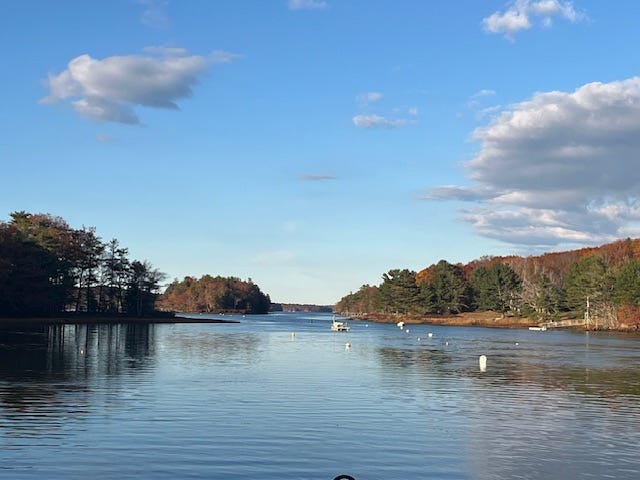

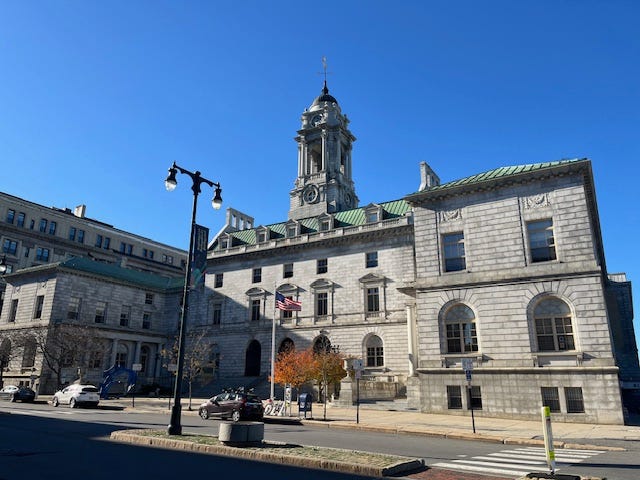
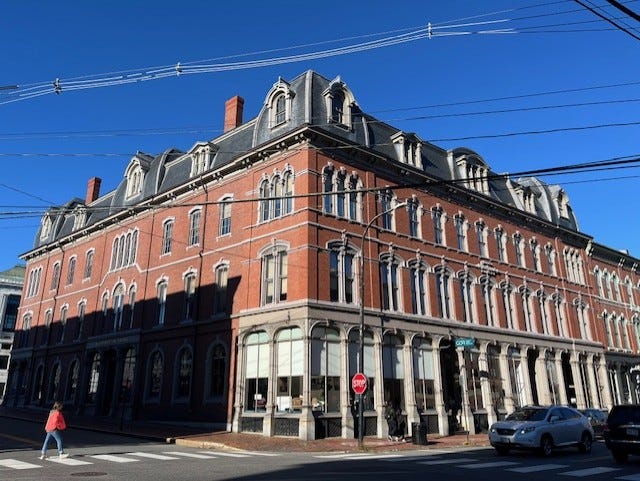
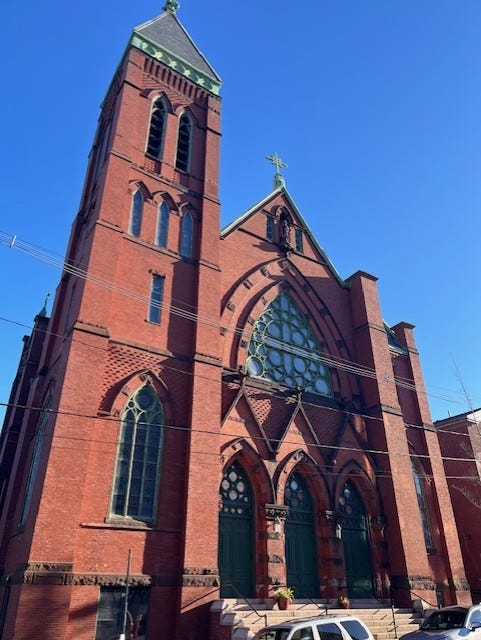
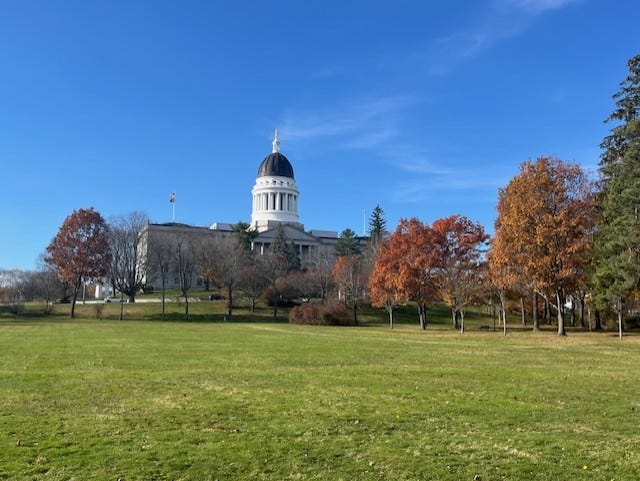
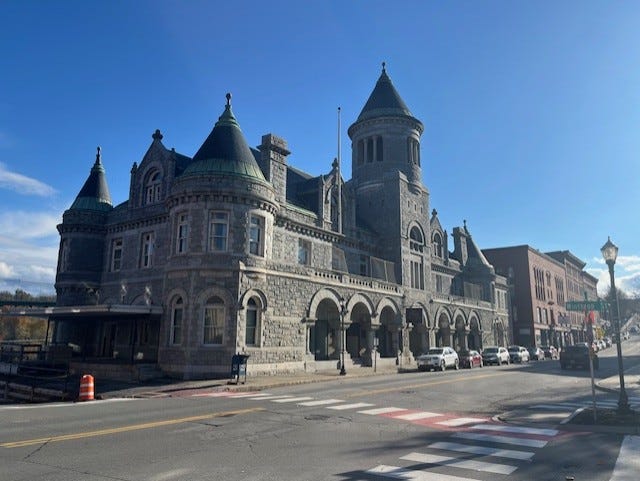

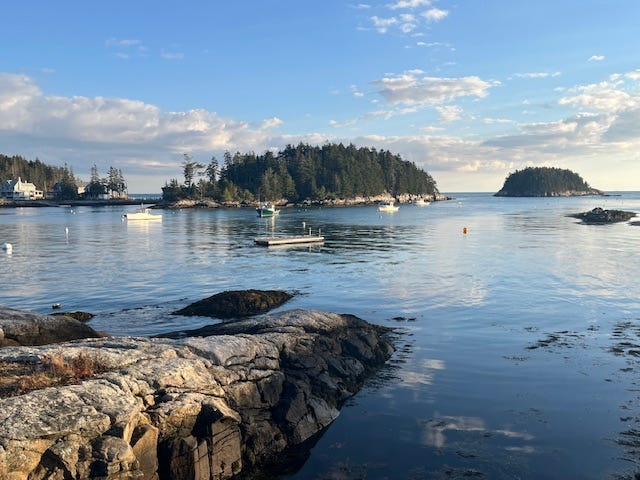
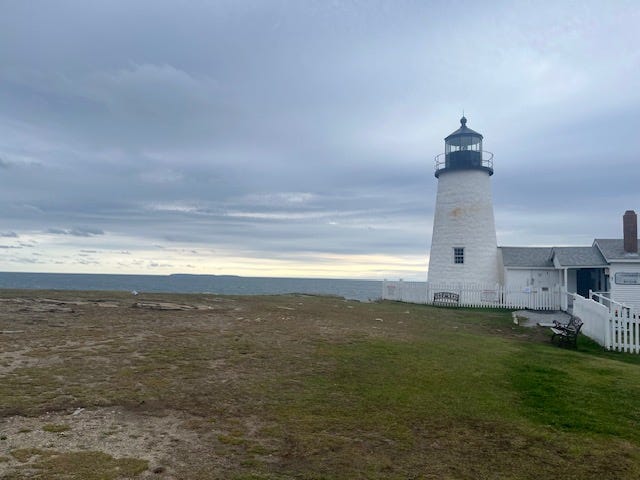

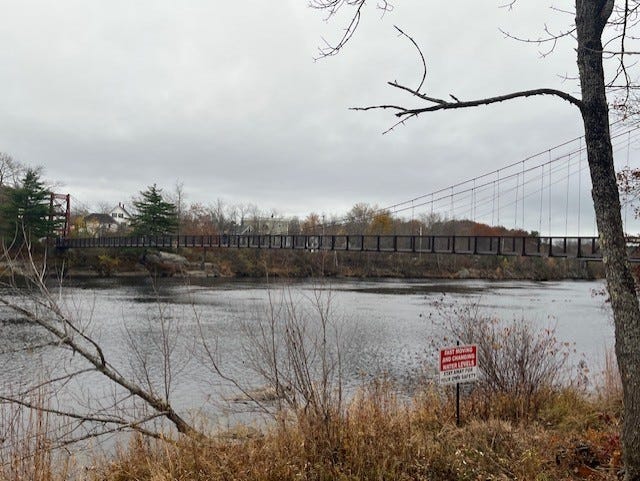

The Maine tourist bureau needs you.